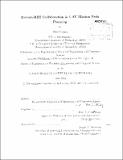| dc.contributor.advisor | Mary L. Cummings. | en_US |
| dc.contributor.author | Griner, Alina | en_US |
| dc.contributor.other | Massachusetts Institute of Technology. Dept. of Electrical Engineering and Computer Science. | en_US |
| dc.date.accessioned | 2013-02-14T15:16:47Z | |
| dc.date.available | 2013-02-14T15:16:47Z | |
| dc.date.copyright | 2012 | en_US |
| dc.date.issued | 2012 | en_US |
| dc.identifier.uri | http://hdl.handle.net/1721.1/76913 | |
| dc.description | Thesis (M. Eng. and S.B.)--Massachusetts Institute of Technology, Dept. of Electrical Engineering and Computer Science, 2012. | en_US |
| dc.description | Cataloged from PDF version of thesis. | en_US |
| dc.description | Includes bibliographical references (p. 147-149). | en_US |
| dc.description.abstract | Unmanned Aerial Vehicles (UAVs) are used for a variety of military and commercial purposes, including surveillance, combat, and search and rescue. Current research is looking into combining automation with human supervision to facilitate various lower-level cognitive tasks, such as path planning, in order to allow the human operator to focus on high-level mission strategy. Path planning in the presence of dynamic constraints necessitates extensive real-time replanning, which is a computationally intensive task, especially when there is a high density of obstacles or no-fly zones. Recently common choices of path finding algorithms have used variations of a randomized algorithm called Rapidly exploring Random Tree (RRT). This randomized sampling algorithm finds fairly short feasible paths, and it finds them efficiently, however human operators supervising UAV missions may have difficulty collaborating with a randomized algorithm. This thesis presents the experimental results of the second round in an iterative interface design project analyzing human collaboration with a RRT algorithm. In the experiment, operators completed simulated UAV missions in three modes with varying methods of interaction with the RRT algorithm. The collected data included performance and behavioral metrics, as well as subjective feedback. The results demonstrated a clear operator preference for certain methods of interaction with RRT over others. The mode of interaction that allowed these preferred methods had similar results in most metrics to the manual planning mode; the mode with the least preferred methods had significantly worse results. The outcome of the experiment did not conclusively answer the question of whether using RRT for path planning results in lower mission completion times or lower cognitive load on the operator, however the analysis of the data and observations of operator behavior lead to questions for future research. | en_US |
| dc.description.statementofresponsibility | by Alina Griner. | en_US |
| dc.format.extent | 149 p. | en_US |
| dc.language.iso | eng | en_US |
| dc.publisher | Massachusetts Institute of Technology | en_US |
| dc.rights | M.I.T. theses are protected by
copyright. They may be viewed from this source for any purpose, but
reproduction or distribution in any format is prohibited without written
permission. See provided URL for inquiries about permission. | en_US |
| dc.rights.uri | http://dspace.mit.edu/handle/1721.1/7582 | en_US |
| dc.subject | Electrical Engineering and Computer Science. | en_US |
| dc.title | Human-RRT collaboration in Unmanned Aerial Vehicle mission path planning | en_US |
| dc.title.alternative | Human-Rapidly exploring Random Tree collaboration in UAV mission path planning | en_US |
| dc.type | Thesis | en_US |
| dc.description.degree | M.Eng.and S.B. | en_US |
| dc.contributor.department | Massachusetts Institute of Technology. Department of Electrical Engineering and Computer Science | |
| dc.identifier.oclc | 824157508 | en_US |
